Pam Tanowitz’s The Spectators at New York Live Arts, May 15 through 18; Bill Young and Colleen Thomas’s A Place in France at 100 Grand Street, May 16 through 19.
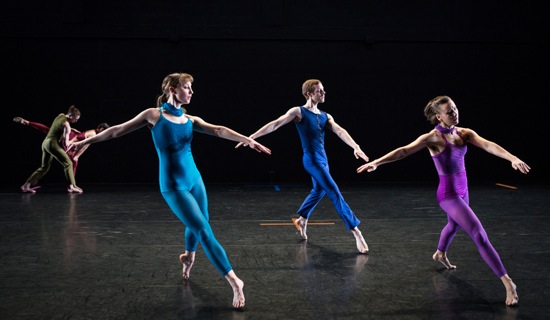
Pam Tanowitz’s The Spectators. Front, L to R: Maggie Cloud, Andrew Champlin, Sarah Haarmann. At back: Pierre Guilbault and Melissa Toogood. Photo: Yi-Chun Wu
Pam Tanowitz’s new The Spectators at New York Live Arts is so clean you could eat off it. Pristine patterns control the six dancers she deploys, and no move they make is blurred or loose. One of Tanowitz’s talents is making cool choreography heat up. Its precision creates a tension with its full-out strenuousness. If these performers were the kind who sweat heavily (and, miraculously, they’re not), they’d be wading.
As in Tanowitz’s previous pieces, her training in Merce Cunningham’s technique and her love of ballet are evident. In much contemporary choreography, the dancers’ legs function mainly to carry them around in various ways; the main action is lodged in their mobile torsos and arms. In The Spectators, feet get a workout, whether aiming at the air or tracing designs on the floor. However, Tanowitz subverts the erect posture of classicism as well as steps that look familiar—pulling a limb askew, making an arm crook, canting a position to the side. She puts unlikely steps and gestures together and makes them look like friends.
And she can startle you. In the middle of a suave, supple, good-behavior solo, Maggie Cloud begins taking big steps, thudding her bare feet on the floor. In the solo that opens the piece, Melissa Toogood, advancing toward and away from the audience and turning, turning, turning, suddenly whips into a fall and ends up lying on her side. On a subtler level, five people may be dancing in unison, and one of them will break into a different step for a few seconds, then drop back into the pattern.
Davison Scandrett’s splendid lighting is also full of surprises. A couple of times, the stage goes dark, except for a sudden blare of footlights, and then swiftly returns to the status quo.
The music, too, has a pleasantly unsettling effect. The first part of The Spectators is accompanied by Dan Siegler’s recorded score—one of fine variety, supportive rhythms, and rich instrumental textures. Then, in the middle of the piece, members of the Flux Quartet walk in and take their places to play Annie Gosfield’s Lightheaded and Heavyhearted and The Harmony of the Body-Machine. The violinists and violist sit out the second of these works, and cellist Felix Fan plays an eerie duet with electronic sounds.
The title of the dance is apt. From time to time, dancers stop moving and watch one another. Tanowitz also treats the space behind the standing sidelights as part of her design. Scandrett illuminates that usually dark backstage area whenever one or more dancers get busy there. Toogood seems about to exit from her first solo; instead, she hangs out for a while, leaning against the proscenium arch, half seen, checking the action.
The dancers’s costumes (by Renée Kurz) vary in cut and color. Toogood wears red and Cloud blue. Sarah Haarmann is in fuschia, Dylan Crossman in burnt orange, Andrew Champlin in navy blue, and Pierre Guilbault in khaki. Six small, rectangular patches of similar colors are placed on the floor along the front and rear edges of the performing space. The dancers’ comings and goings, pairings and separations are absorbing to watch. Maybe you admire the three women, facing front and dancing in immaculate unison—their straight arms, tilting bodies, and busy feet detonating designs on the air. Maybe what draws your eyes is Champlin, passing through with a mazurka step that no one else appears to know. Or Haarmann taking big, turning paces back and forth along a diagonal, while bent over and staring in those two directions with what might almost be apprehension. These greatly gifted dancers are jumpers, and often someone leaps high into the action with no obvious preparation.
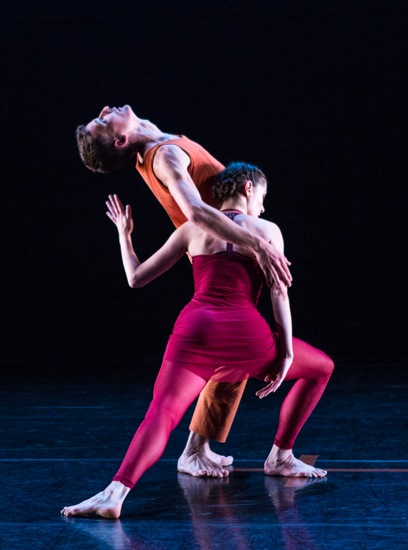
Dylan Crossman and Melissa Toogood in the final duet of Tanowitz’s The Spectators. Photo: Yi-Chun Wu
Often the performers handle one another quite casually. Guilbault and Champlin pick up Cloud in passing and carry her away. At other times, an enigmatic purposefulness colors their actions. Cloud pulls Champlin into a deeper lunge so she can copy him. In the final moments of the piece, Crossman, who has danced a complex and intriguing solo, comes together with Toogood for an equally intriguing duet, in which the two link up or shadow each other. After a while, they travel forward along the track that Toogood established in her opening solo. When they come close to the audience—surprise!— he touches her cheek, and as they retreat, they kiss. The cello goes wild, then settles into something like a folk-dance rhythm. In the final moments, Toogood is alone again, spinning chains of turns.
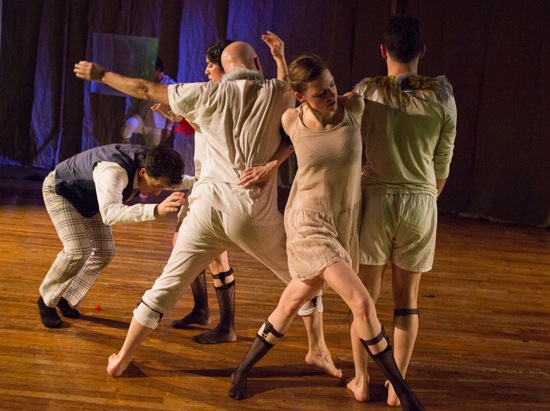
Bill Young and Colleen Thomas’s There’s a Place in France. L to R: Pedro Osorio, Colleen Thomas, Anthony Phillips, Denisa Musilova, Darrin Wright. Photo: Yi-Chun Wu
I like to think that only in New York City could you go on consecutive days from New York Live Arts’ stylishly anonymous black-box theater and the arrowy clarity of Pam Tanowitz’s The Spectators to Bill Young and Colleen Thomas’s bedecked loft and the couple’s A Place in France, in which blurred edges and dreamlike illusions nibble surreptitiously away at the craftsmanship that, nonetheless, supports the work.
Going to 100 Grand Street to see A Place in France causes me to flash back to the 1970s, when choreographers such as Trisha Brown, David Gordon, Meredith Monk, and Douglas Dunn showed work in the studios where they lived and labored (in a city transformed by landlord avarice, Dunn is one of the few artists who does this now). You wait on wooden stairs worn down by the feet of years-ago factory workers until the door opens and you can enter and wedge yourselves into folding chairs. The studio is large, but not enormous. A long rectangular glass tank containing a couple of inches of water is very close to some front-row spectators’ toes.
Look around. The studio mirror has thin vertical strips glued to it. Sheets of crumpled brown paper cover two other walls and a corner. Little red lights dangle from cords near an upright piano whose rear surface is ornamented with red and blue balloons. A clear plastic sheet hangs on one side of the space. A translucent plastic rectangle the size of a large television screen hangs farther back. Near the mirror, three slings are suspended from the ceiling on ropes. Rebecca MK Makus’s lighting and visual design has already set us up for trickery and illusion.
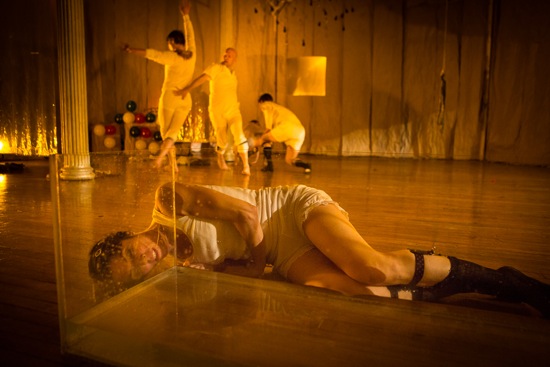
Foreground by tank: Colleen Thomas. At back, L to R: Michael Ingle, Anthony Phillips, Darrin Wright. Photo: Yi-Chun Wu
Are we in a carnival funhouse? A dream? Could be either. Or perhaps the playground of some very sophisticated children. I’m pleased to note that the remarkable composer-musician-performer John McGrew credits “the young musicians at Choo Choo Train Pre-K in Brooklyn” with helping him write the lyrics for some of the songs in A Place in France.
The naughty schoolyard ditty that gives the piece its title is sung sotto voce by Anthony Phillips in his opening solo: “There’s a place in France/ Where the ladies wear no pants.” But after the opening line, his voice trails off, and, as he’s dancing around, he adds, “and the men like that.”
When he lifts his long shirt, the butt he wiggles at us is clad in underpants trimmed with rows of red feathers. That explains, sort of, the barnyard squawk he let out seconds earlier. Or was that about echoing (or foreshadowing?) the trombone hefted by McGrew? Phillips’ dancing is a winning mixture of cockiness, slinkiness, and gravitas. When he’s finished, he goes and stands behind the tv-ish panel; seen through it, his head becomes enormous. After that, he slips into a sling and joins Michael Ingle and Darrin Wright in some synchronized swinging.
How do you write about this exhilarating circus of a piece? It’s definitely about more than dancing—although there’s plenty of that. In some sense, it’s about putting on a show. People are always ready to fix one another up. The basic costumes by Juli and Alex Albene consist of white underwear on the butch side; sock garters are de rigeur whether or not socks are in evidence. Over these, dresses, shirts, trousers etc. are handed out and helped with. Only Pedro Osorio arrives presentably outfitted; still, all gather to do a little tweaking.
The tank of water presents a trial of some sort. Denisa Musilova steps into it and wades for a few seconds. Intermittently throughout the hour, others approach it less tentatively. Wright sticks his head in and shakes the drops out of his hair. Musilova and Thomas hold hands and dance in it; Thomas sits in it briefly. At the end, Phillips lowers himself slowly into the water until he’s lying down. That’s the final image.
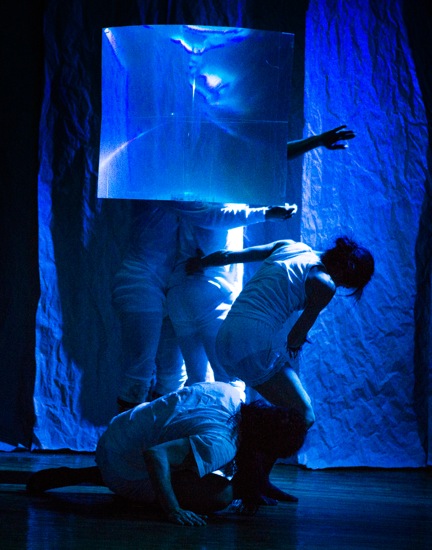
Pedro Osorio (L) and Colleen Thomas. Behind panel: Michael Ingle and Anthony Phillips. On panel: Ingle’s upside-down head. Photo: Yi-Chun Wu
Sometimes Makus’s lighting changes drastically; the room becomes all red, all blue. Peter Richards projects videos (live-feed, I believe) on the crumpled paper of one corner; the images stretch and flicker and distort. McGrew is a musical polymath. Now he’s on trumpet, now at the piano, now squeezing an accordion, now with a harmonica in his mouth. All in service to the ambiance of the moment. He sings too, in a high, sweet, rueful voice.
Nor does he stay at the edges of the action. In one vignette, he joins others in a clump, and, when they fall in a heap and lie in positions that summon up images of battlefield dead, he ends up with his head pillowed on Phillips. In this position, he begins to sing about “glow power,” which is “something that makes you brave; you get it from the sun. . . .” Thomas is the only one who hasn’t collapsed; she stands with her back to the audience, unmoving. McGrew, singing on, crawls to her and grabs her ankle. Suddenly everyone else wakes up, falls back, sits up. Thomas stomps. They all fall again. A game, perhaps, with dark undertones.
A lot of what happens in A Place in France is tender in a no-nonsense way. People are always recovering, bouncing back. Six people pair up and dance together, no rules about gender. The movements are juicy, weighted, rough around the edges. When Phillips (what a performer!) talks quietly about a dream, with the pungent recurring line, “I need to be soft again,” others take turns settling him down or holding him up; McGrew, walking him along, begins to echo his words.
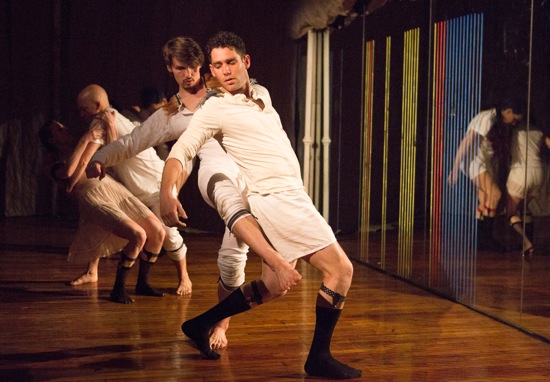
Foreground: Ingle (L) and Wright. Behind them: Denisova and Phillips. Reflected in mirror: Osorio and Thomas. Photo: Yi-Chun Wu.
And there are small, offbeat celebrations. Some of the balloons get popped by bumping bodies. While a recorded soprano sings a fragment of one of the rippling folk songs of the Auvergne, Osorio performs a powerful, wrenched-about solo and, at the end of it, releases a small tempest of glitter.
The marvelous performers together create something ineffably magical—both childlike and seriously adult. A Place in France slips about the way dreams do. Imagination and wit run hand in hand with beauty—lose and gain, fall down and get up, run some more.

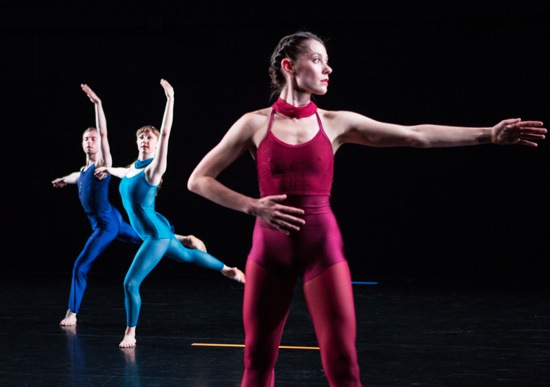
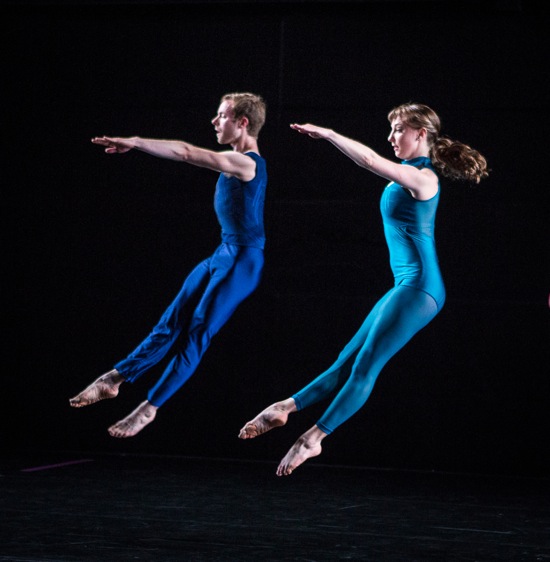
It was also good to be able to see Tanowitz’s piece for New York Theatre Ballet,
“Short Memory,” at the company’s Dance on a Shoestring performance the same
weekend.